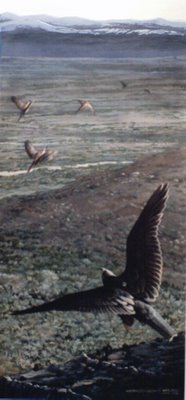IN SUPPORT OF SPUGS
 Commensalism is the dependence of one species on another in a relationship just a bit south of true parasitism. A number of human commensals are familiar, the rodent genera Rattus and Mus, the Common Starling (Sturnus vulgaris) and Rock Dove (Columba livia)--creatures despised and maligned by most. It's pretty tough, though, not to be charmed by the jaunty little English Sparrow (Passer domesticus). The black bib and bright brown back of the male can be seen bouncing merrily along sidewalks throughout the world. A poet friend of mine calls them “Party Birds.” In falconry slang, the word “Spug” is borrowed from old Scottish. I think either term works well.
Commensalism is the dependence of one species on another in a relationship just a bit south of true parasitism. A number of human commensals are familiar, the rodent genera Rattus and Mus, the Common Starling (Sturnus vulgaris) and Rock Dove (Columba livia)--creatures despised and maligned by most. It's pretty tough, though, not to be charmed by the jaunty little English Sparrow (Passer domesticus). The black bib and bright brown back of the male can be seen bouncing merrily along sidewalks throughout the world. A poet friend of mine calls them “Party Birds.” In falconry slang, the word “Spug” is borrowed from old Scottish. I think either term works well. The taxonomical placement of the Spug and his 20 or so congeners has been the subject of much debate. Not closely related to the American sparrows, for years they resided in the weaver family, Ploceidae, then found themselves lumped for a time with the family Estrildidae, which includes most of the well-known cage finches. Today most authorities follow Sibley in placing them in the family Passeridae, along with pipits, wagtails and accentors. Most anywhere in Africa and Eurasia one or more Passer species is native, and a number of them have been human commensals for millenia. The Eurasian Tree Sparrow (P. montanus) has pioneered frontiers as far-flung as Missouri, but it's P. domesticus that has shown true genius at the art of commensalism, with a present range that extends from Australia through urban and rural situations in both Americas. Spugs have learned to thrive in a variety of settings, often living their whole lives indoors, successfully breeding in shopping malls and warehouses. There is even a record of a pair successfully raising a brood in an English coal mine 640 meters below the ground.
Toward the end of the nineteenth century, Eugene Schieffelin, a British expatriot living in New York City, embarked on a little project that would secure his place in ornithological history. Obsessed both with birds and Shakespeare, Schieffelin set out to introduce every bird species mentioned by the Bard into Central Park. Today we remember him as the Victorian ninny who brought us ecological doom in avian form, but what's often forgotten is that Shieffelin was a member of an “acclimatization society,” one of many groups dedicated to redistributing favorite animals and plants. During this time, such projects were all the rage, but were almost invariably failing propositions. Schieffelin's starlings and sparrows thrived well enough, but let's not forget his Eagle Owls, Blackbirds, Nightingales, and all the others doomed to bachelor deaths in the Big Apple.
Young Spugs grow quickly, and can fledge at less than two weeks of age. It is normal for a pair to fledge three different broods in a season, and as many as seven broods have been recorded. Their fecundity and willingness to eat nearly anything helped them spread across the North American continent in a few decades, radiating into new ecological niches, and showing astonishing physical change in well under a century, the big, dark birds of the Pacific Northwest contrasting with their small, paler brethren of the desert Southwest and their brightly-colored Eastern kin.
As they've invaded new spaces, English Sparrows have had their effect on the ecology at large. Far slower than any native passerine bird, their presence has affected the behavior of certain predators. In many American cities, the once bashful Cooper's and Sharp-shinned Hawks (Accipiter cooperi and A. striatus) have taken up urban living, and in the winter are exceptionally common now in many cities, a fact I attribute to the Spug. In 1980 I found a Cooper's Hawk nest in the heart of Salt Lake City. At the time I could find no previous citation of an urban Cooper's nest in the literature. Today they are not uncommon. American Kestrels (Falco sparverius) have also learned to exploit the easy quarry, and in doing so, I believe have become more ornithophagic in general. I've noticed that urban and rural kestrels in my area bring far more native birds to the nest than do those in more pristine habitats. In 1992 I saw a suburban falcon kestrel nail an adult Mourning Dove (Zenaida macroura) in the air, an act unimaginable from the truly wild, grasshopper and vole-eating kestrels I grew up with.
Commensal birds also displace natives, and are roundly vilified for it. Much is made of the effect English Sparrows and Common Starlings have on cavity-nesting birds, most notably bluebirds (Sialia spp.), whose nests they often appropriate. Of course, this only happens in habitats that have already been severely altered by human development, so it's a little disingenuous to blame the birds for continuing our own effect. The best way to conserve native birds is to leave their habitat alone in the first place. Like all our other commensals, the Spug will be a part of us for the foreseeable future, and I, for one, am happy to have him along for the ride. On this Mardis Gras, let's all drink a toast to the health of the Party Birds!
___________________
upper: A BRICK HOUSE--ENGLISH SPARROW & PAPER WASP (1992) acrylic 18" x 16"
lower: AN AMERICAN DREAM--ENGLISH SPARROWS & COMMON STARLINGS (1988) acrylic 18" x 24"




























